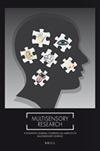Dynamic Weighting of Time-Varying Visual and Auditory Evidence During Multisensory Decision Making.
IF 1.5
4区 心理学
Q3 BIOPHYSICS
引用次数: 0
Abstract
Perceptual decision-making in a dynamic environment requires two integration processes: integration of sensory evidence from multiple modalities to form a coherent representation of the environment, and integration of evidence across time to accurately make a decision. Only recently studies started to unravel how evidence from two modalities is accumulated across time to form a perceptual decision. One important question is whether information from individual senses contributes equally to multisensory decisions. We designed a new psychophysical task that measures how visual and auditory evidence is weighted across time. Participants were asked to discriminate between two visual gratings, and/or two sounds presented to the right and left ear based on respectively contrast and loudness. We varied the evidence, i.e., the contrast of the gratings and amplitude of the sound, over time. Results showed a significant increase in performance accuracy on multisensory trials compared to unisensory trials, indicating that discriminating between two sources is improved when multisensory information is available. Furthermore, we found that early evidence contributed most to sensory decisions. Weighting of unisensory information during audiovisual decision-making dynamically changed over time. A first epoch was characterized by both visual and auditory weighting, during the second epoch vision dominated and the third epoch finalized the weighting profile with auditory dominance. Our results suggest that during our task multisensory improvement is generated by a mechanism that requires cross-modal interactions but also dynamically evokes dominance switching.多传感器决策过程中时变视觉和听觉证据的动态加权。
动态环境下的感知决策需要两个整合过程:整合来自多种形态的感官证据以形成对环境的连贯表征;整合跨时间的证据以准确做出决策。直到最近,研究才开始揭示两种模式的证据是如何随着时间的推移而积累起来形成感知决策的。一个重要的问题是,来自单个感官的信息是否同样有助于多感官决策。我们设计了一个新的心理物理任务来衡量视觉和听觉证据是如何随时间加权的。参与者被要求根据对比度和响度区分两种视觉光栅和/或分别呈现给右耳和左耳的两种声音。随着时间的推移,我们改变了证据,即光栅的对比度和声音的振幅。结果显示,与单感觉试验相比,多感觉试验的性能准确性显著提高,这表明当有多感觉信息可用时,两个来源之间的区分得到了改善。此外,我们发现早期证据对感官决策贡献最大。视听决策过程中感官信息的权重随时间动态变化。第一阶段以视觉和听觉加权为主,第二阶段以视觉为主,第三阶段以听觉为主。我们的研究结果表明,在我们的任务过程中,多感官的改善是由一种需要跨模态交互的机制产生的,但也动态地唤起了优势转换。
本文章由计算机程序翻译,如有差异,请以英文原文为准。
求助全文
约1分钟内获得全文
求助全文
来源期刊

Multisensory Research
BIOPHYSICS-PSYCHOLOGY
CiteScore
3.50
自引率
12.50%
发文量
15
期刊介绍:
Multisensory Research is an interdisciplinary archival journal covering all aspects of multisensory processing including the control of action, cognition and attention. Research using any approach to increase our understanding of multisensory perceptual, behavioural, neural and computational mechanisms is encouraged. Empirical, neurophysiological, psychophysical, brain imaging, clinical, developmental, mathematical and computational analyses are welcome. Research will also be considered covering multisensory applications such as sensory substitution, crossmodal methods for delivering sensory information or multisensory approaches to robotics and engineering. Short communications and technical notes that draw attention to new developments will be included, as will reviews and commentaries on current issues. Special issues dealing with specific topics will be announced from time to time. Multisensory Research is a continuation of Seeing and Perceiving, and of Spatial Vision.
 求助内容:
求助内容: 应助结果提醒方式:
应助结果提醒方式:


